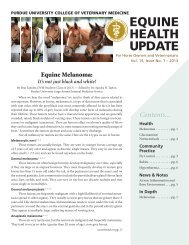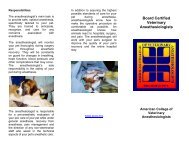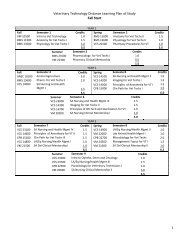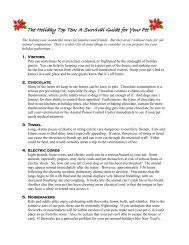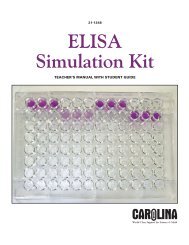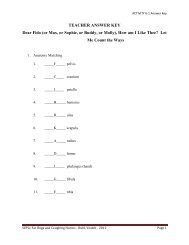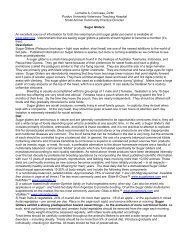Detection of reactive oxygen species by flow ... - ResearchGate
Detection of reactive oxygen species by flow ... - ResearchGate
Detection of reactive oxygen species by flow ... - ResearchGate
Create successful ePaper yourself
Turn your PDF publications into a flip-book with our unique Google optimized e-Paper software.
Journal <strong>of</strong> Neuroscience Methods 120 (2002) 105/112www.elsevier.com/locate/jneumeth<strong>Detection</strong> <strong>of</strong> <strong>reactive</strong> <strong>oxygen</strong> <strong>species</strong> <strong>by</strong> <strong>flow</strong> cytometry after spinalcord injuryJian Luo a , Nianyu Li b , J. Paul Robinson b , Riyi Shi a, *a Department <strong>of</strong> Basic Medical Sciences, Center for Paralysis Research, School <strong>of</strong> Veterinary Medicine, Purdue University, West Lafayette,IN 47907, USAb Department <strong>of</strong> Basic Medical Sciences, Cytometry Laboratories, Purdue University, West Lafayette, IN 47907, USAReceived 5 March 2002; received in revised form 30 May 2002; accepted 2 July 2002AbstractThe monitoring <strong>of</strong> <strong>reactive</strong> <strong>oxygen</strong> <strong>species</strong> (ROS) levels in injured nervous tissue is critical for both studying the mechanism <strong>of</strong>secondary damage and evaluating the effectiveness <strong>of</strong> antioxidants. Flow cytometry is an excellent method to detect ROS in culturedcells and naturally suspended individual cells. However, its use in nervous tissue is limited due to the difficulties in obtaining singlecells in suspension. We have developed a new method which minimizes the error during conventional dissociation. Specifically, weintroduced a fixation step (with formaldehyde) between the dye loading and dissociation. As a result, the post-injury ROS signalsdetected <strong>by</strong> <strong>flow</strong> cytometry increase significantly when using hydroethidine as superoxide indicator. The injury-induced elevation <strong>of</strong>ROS obtained from this new method was also in better agreement with the two other standard ROS detection methods, fluorescencemicroscopy and lipid peroxidation assay. Furthermore, more pronounced decrease <strong>of</strong> ROS was found in this improved method inresponse to treatment with a superoxide scavenger, manganese(III)tetrakis(4-benzoic acid)porphyrin. Based on these observations,we suggest that the data obtained from the cells <strong>by</strong> this new method are more accurate than those from the classic cell dissociationmethod that dissociates cells directly from fresh tissues. # 2002 Elsevier Science B.V. All rights reserved.Keywords: Flow cytometry; Reactive <strong>oxygen</strong> <strong>species</strong>; Scavenger; Lipid peroxidation; Spinal cord injury; Formaldehyde1. IntroductionIncreasing evidence suggests that <strong>reactive</strong> <strong>oxygen</strong><strong>species</strong> (ROS) are important mediators <strong>of</strong> secondaryinjury in CNS trauma (Hall, 1989; Coyle and Puttfarcken,1993). It is well established that ROS increasesignificantly following CNS mechanical trauma in liveanimals (Hall, 1989). The inhibition <strong>of</strong> ROS has beenshown to provide behavioral and functional recoveryfollowing various types <strong>of</strong> injuries (Hall, 1995). Therefore,it is important to develop reliable, accurate assaysto monitor ROS levels in different compartments <strong>of</strong> thetissue for both studying the mechanism <strong>of</strong> injury andevaluating the effectiveness <strong>of</strong> antioxidants. Currently,there are many methods available to evaluate ROS,including lipid peroxidation (LPO) assay, electron spin* Corresponding author. Tel.: /1-765-496-3018; fax: /1-765-494-7605E-mail address: riyi@vet.purdue.edu (R. Shi).resonance (ESR), and image analysis-based fluorescencemicroscopy using ROS-specific fluorescent dyes.In recent years, <strong>flow</strong> cytometry has emerged as aneffective rapid method to specifically detect intracellularROS. The major advantage <strong>of</strong> <strong>flow</strong> cytometry is that,unlike other available methods, intracellular ROS levelscan be evaluated on a cell-<strong>by</strong>-cell basis in the absence <strong>of</strong>tissue background. Despite the frequent use <strong>of</strong> suchmethod in detecting ROS in neutrophils, lymphocytes orcultured cells (Robinson, 1993; Carter et al., 1994), itsability to detect ROS in nervous tissue is limited. Themain reason is that in order to utilize <strong>flow</strong> cytometer,the neurons in CNS tissue must be dissociated intosingle cells in suspension. This dissociation process,unfortunately, can introduce error <strong>by</strong> eliminating fragilecells which usually have higher level <strong>of</strong> ROS or causingROS production. The purpose <strong>of</strong> this study is tointroduce a new procedure to reduce the error accruedduring the dissociation process and facilitating the use<strong>of</strong> <strong>flow</strong> cytometry in research involving nervous tissue.0165-0270/02/$ - see front matter # 2002 Elsevier Science B.V. All rights reserved.PII: S 0 1 6 5 - 0 2 7 0 ( 0 2 ) 0 0 1 9 3 - 0
106J. Luo et al. / Journal <strong>of</strong> Neuroscience Methods 120 (2002) 105/112We have found that a fixation step introduced afterthe dye loading and before the dissociating proceduresignificantly increased the post-injury ROS signalsdetected <strong>by</strong> <strong>flow</strong> cytometry compared to that withoutthe fixation step. The data obtained from this newmethod was in overall better agreement with two otherstandard ROS detection methods, image analysis-basedfluorescence microscopy and LPO assay. This methodmay facilitate the more frequent use <strong>of</strong> <strong>flow</strong> cytometryin free radical research in nervous tissue.2. Methods and materials2.1. In vitro spinal cord injury modelAll animals used in this study were handled in strictaccordance with the NIH guide for the Care and Use <strong>of</strong>Laboratory Animals and the experimental protocol wasapproved <strong>by</strong> the Purdue Animal Care and UsageCommittee. In these experiments, every effort wasmade to reduce the number and suffering <strong>of</strong> the animalsused. Adult Hartley guinea pigs, weighing 300/500 gwere anesthetized deeply with a mixture <strong>of</strong> ketamine (60mg/kg) and xylazine (10 mg/kg). They were thenperfused through the heart with 500 ml <strong>of</strong> <strong>oxygen</strong>ated,cold Krebs’ solution to remove blood and lower coretemperature. The vertebral column was excised rapidlyand a complete laminectomy was performed. The spinalcord was removed from the vertebrae and immersed incold Krebs’ solution. The cord was separated into twohalves <strong>by</strong> midline sagittal division. The composition <strong>of</strong>the modified Krebs’ solution was as follows: NaCl, 124mM; KCl, 2 mM; KH 2 PO 4 , 1.2 mM; MgSO 4 , 1.3 mM;CaCl 2 , 2 mM; dextrose, 20 mM; NaHCO 3 , 26 mM,equilibrated <strong>by</strong> bubbling with 95% O 2 /5% CO 2 toproduce a pH <strong>of</strong> 7.2/7.4. The spinal cords weremaintained in <strong>oxygen</strong>ated Krebs’ solution at 37 8C for1 h before the onset <strong>of</strong> the experiment to ensure recoveryfrom dissection before experimentation. All the sampleswere bubbled with 95% O 2 /5% CO 2 throughout theduration <strong>of</strong> the experiment.The spinal cord strips were randomly divided intothree groups: control-uninjured (control), compressionuntreated(injury), and compression-treated (treated).The control-uninjured group did not receive any compression.The compression-untreated group received thecompression injury which was induced <strong>by</strong> a constantdisplacement <strong>of</strong> 5 s compression <strong>of</strong> the spinal cord usinga modified forceps possessing a spacer. The compression-treatedgroup was placed in the modified Krebs’solution containing 100 mM manganese(III)tetrakis(4-benzoic acid)porphyrin (MnTBAP) immediately aftercompression. MnTBAP is a cell-permeable superoxidescavenger. All experiments were performed at 37 8C.One hour after injury, the spinal cord strips weretaken out <strong>of</strong> the Krebs’ bath and the center <strong>of</strong> the injurysite (about 6 mm long) was obtained and the ROSmeasurements were performed.2.2. Detecting ROS using <strong>flow</strong> cytometryHydroethidine (HE) was used as a superoxide indicator.HE is oxidized selectively <strong>by</strong> superoxide toethidium, whose fluorescence intensity within the cell isproportional to the total production <strong>of</strong> superoxide(Rothe and Valet, 1990; Bindokas et al., 1996). Theoxidation <strong>of</strong> HE is not accomplished <strong>by</strong> hydroxylradical, singlet O 2 ,H 2 O 2 or nitrogen radicals (Bindokaset al., 1996).2.2.1. Isolating cells for <strong>flow</strong> cytometry2.2.1.1. Method A. This method was optimized forinjured spinal cord from the cell dissociation methodsused in most literature (Grogan and Collins, 1990;Watson, 1991; Visscher and Crissman, 1994; Diamondet al., 2000). The isolation procedure was performed onfresh tissues using a mixture <strong>of</strong> enzymes after mechanicalmincing. Briefly, spinal cord strips, from the center<strong>of</strong> the injury site, were minced with a surgical blade. Theminced tissue was disaggregated first <strong>by</strong> an automaticmechanical procedure using BD Medimachine (BDBiosciences, San Jose, CA) for 15 s. The resultant tissuewas then incubated in 1 ml <strong>of</strong> previously <strong>oxygen</strong>ated(95% O 2 /5% CO 2 ) dissociation solution for 20 min andkept <strong>oxygen</strong>ated during the dissociation process. Thedissociation solution contained 0.5 mg/ml collagenaseand 0.1 mg/ml trypsin in Krebs’ solution. The concentrations<strong>of</strong> the enzymes and duration <strong>of</strong> incubation wereoptimized to enable effective dissociation <strong>of</strong> cells and atthe same time cause minimal cell damage based on theobservation <strong>of</strong> production <strong>of</strong> subcellular debris. Duringdissociation, the tissue was gently triturated with a 2 mlpipette (10 strokes). After 20 min dissociation, theremaining tissue was removed and the suspensionswere spun at 300/g for 10 min, the dissociationsolution was aspirated and the cells were washed twicewith PBS before dye loading. Pelleted cells were washedwith 2 ml PBS and centrifuged as above. Undisaggregatedtissue debris and doublets were removed <strong>by</strong>filtration through a mesh (60 mm). The resultant cells(10 6 ) were then incubated in 1 ml <strong>of</strong> 1 mM HE solutionat 37 8C for 5 min in the dark. Cells were then washedtwice in PBS <strong>by</strong> two additional spinning/washing cyclesand resuspended in 1 ml <strong>of</strong> PBS for <strong>flow</strong> cytometricanalysis.2.2.1.2. Method B. The major differences betweenmethods A and B were that the fluorescence dye wasloaded before the dissociation procedure and the tissue
J. Luo et al. / Journal <strong>of</strong> Neuroscience Methods 120 (2002) 105/112 107was immediately fixed after dye loading; therefore, thedissociation was performed on the fixed tissues. Thespinal cord strips were incubated with 1 ml <strong>of</strong> PBS withHE at final concentrations <strong>of</strong> 1 mM for 5 min at 37 8Cin the dark. The strips were then fixed with 3.7%formaldehyde for 2 h. After fixation, the spinal cordstrips were subjected to rehydration <strong>by</strong> incubation inPBS overnight. The aim <strong>of</strong> the rehydration procedurewas to remove the formaldehyde to prevent the inactivation<strong>of</strong> enzymes used to digest the tissue (Gibellini etal., 1995). After rehydration, the spinal cord strips wereminced manually. The minced tissue was disaggregatedusing BD Medimachine (BD Biosciences, San Jose, CA)for 25 s and incubated in enzymatic dissociationsolution for 20 min. The dissociation mixture contained5 mg/ml collagenase and 1 mg/ml trypsin in Krebs’solution. During dissociation, the tissue was gentlytriturated with a 2 ml pipette (maximum <strong>of</strong> 20 strokes).After the remaining tissue was removed, the suspensionswere spun at 300/g for 10 min and the dissociationsolution was aspirated. Pelleted cells were washed with 2ml PBS and centrifuged as above. Undisaggregatedtissue debris and doublets were removed <strong>by</strong> filtrationthrough a 60 mm metal mesh. The final cells (10 6 ) wereresuspended in 1 ml PBS and were analyzed <strong>by</strong> <strong>flow</strong>cytometry immediately.2.2.2. Flow cytometry analysisFlow cytometric data acquisition and analysis wereperformed on an EPICS XL cytometer (Beckman-Coulter, Miami, FL). The <strong>flow</strong> cytometer was equippedwith an argon ion laser with excitation at 488 nm and a15 mW output power. The red fluorescence <strong>of</strong> ethidiumwas monitored using a 610 nm long pass filter. Electronicgating was used to exclude doublets and subcellulardebris. Specifically, a forward scatter (FSC) thresholdwas set to eliminate most <strong>of</strong> the subcellular debris. Foreach parameter investigated, at least 2/10 4 events(cells) were analyzed per sample. The following datawere collected: forward scatter, 908 scatter, and themean fluorescence intensity <strong>of</strong> ethidium signals (aslogarithmically amplified data).Since we introduced a fixing step in method B, wewanted to know the effect <strong>of</strong> the fixation procedure onthe fluorescence intensity <strong>of</strong> HE. This was done <strong>by</strong>comparing the fluorescence intensity in the same cellpopulation with and without fixation.As compared with unfixed samples, the fixed samplesshowed an average 6/10% increase <strong>of</strong> fluorescenceintensity in both control and injured groups (data notshown). The fixation did not significantly affect themean coefficient variation (data not shown), and theincrease was cancelled out when expressed as a percentage<strong>of</strong> the control.2.3. Morphological studies using fluorescence microscopyIn order to observe the morphology change afterisolation, the isolated single cells were observed under afluorescence microscope. This was done immediatelywhen the cells were ready for <strong>flow</strong> cytometry (beforeresuspension) <strong>by</strong> dropping the pellets directly onto theglass slides and observing immediately under an OlympusVanox fluorescence microscope (excitation filter: BP545 nm; barrier filter: 0/590 nm).2.4. Detecting ROS using fluorescence microscopyIn order to compare the accuracy <strong>of</strong> the <strong>flow</strong>cytometry data obtained from the cells dissociated <strong>by</strong>methods A and B, we used fluorescence microscopy tomeasure the fluorescence intensity. For the fluorescencemicroscopy experiment, the dye loading and fixationwas the same as described above in method B. Afterfixation, the segments were cut into sections <strong>of</strong> 40 mm,using an EMS-4000 Tissue Slicer (Electron MicroscopySciences, Fort Washington, PA). The sections weredehydrated and mounted on glass slides with DPX.The sections were then observed with an OlympusVanox fluorescent microscope (excitation filter: BP 545nm; barrier filter: 0/590 nm). HE fluorescence imageswere captured through a 2/ objective, using a highresolutionCCD camera (DEI-750, Optronic Eng.,Goleta, CA). At this magnification, we were able tocapture the whole section with just one image. Theimages were saved for later analysis and quantification.Camera exposure and light settings were kept constantduring each experiment.Quantification was performed from coded slides <strong>by</strong> anindividual who did not know the treatment history <strong>of</strong>the specimen. The fluorescence intensity measurementswere carried out <strong>by</strong> an image analysis program, SigmascanPro (SPSS Science, Chicago, IL). For each tissuesample, which was about 6 mm long, five sections werechosen randomly and the fluorescent intensity wasmeasured separately. An average <strong>of</strong> the values fromthese five sections was calculated and used as the finalfluorescent value <strong>of</strong> the cord sample. For each sectionimage, the area occupied <strong>by</strong> the spinal cord tissue wascarefully delineated manually along the edge and thefluorescent intensity <strong>of</strong> the tissue was taken. Foursmaller areas (5% <strong>of</strong> the total field) were randomlyselected at each corner (outside <strong>of</strong> the spinal cord tissue)and the average fluorescence intensities <strong>of</strong> these fourareas were used as background intensity. The fluorescenceintensity <strong>of</strong> the spinal cord samples was obtained<strong>by</strong> subtracting the background fluorescence from that <strong>of</strong>the spinal cord image and expressed in arbitrary units.
1082.5. Lipid peroxidation assayJ. Luo et al. / Journal <strong>of</strong> Neuroscience Methods 120 (2002) 105/1123.2. Histogram resolution and light scatter propertiesLPO was analyzed using a Lipid HydroperoxideAssay Kit from Cayman Chemical Company (AnnArbor, MI). The spinal cord strips obtained from thecenter <strong>of</strong> the injury site were weighed and homogenized.The homogenization was carried out in a Teflon/glasshomogenizer in the modified Krebs’ solution to obtain a10% (w/v) whole homogenate. Immediately after homogenization,lipid hydroperoxides were extracted from thesample into chlor<strong>of</strong>orm. The measurement was thenperformed immediately upon extraction. The chromogenicreaction was conducted at 37 8C for 5 min. Theabsorbance was read at 500 nm using a 96-well platereader on a spectrophotometer (SLT spectra platereader, SLT Labinstrument, Salzburg, Austria). 13-HpODE (13-hydroperoxy octadecadienoic acid) wasused as the standard. Tissue lipid peroxide was calculatedand expressed as nanomoles per 100 mg <strong>of</strong> wettissue (nmol/100 mg).2.6. Chemicals and reagentsHE was purchased from Molecular Probe (Eugene,OR). Lipid Hydroperoxide Assay Kit and MnTBAPwere purchased from Cayman Chemical Company (AnnArbor, MI). DPX Mountant for histology and all otherchemicals used were obtained from Sigma Chemical Co.(St. Louis, MO).2.7. StatisticsAll data are represented as means9/SD. Statisticalanalysis was performed using the Student’s t-test.Values were accepted as being statistically significantlydifferent if a P-value was B/0.05.3. Results3.1. Overall cell yields and morphology after isolationIn this study, the mean weight <strong>of</strong> the fresh spinal cordstrips, about 6 mm from the injury center, was 272 mg.The mean cellular yield <strong>of</strong> method A was 3.5/10 6 cells,while that <strong>of</strong> method B was 4.1/10 6 . The standardprotocol requires a final cell concentration <strong>of</strong> 1/10 6cells suspended in 1 ml. Therefore, both methodsprovide sufficient cells. Furthermore, under the fluorescencemicroscope, there is no difference between themorphology <strong>of</strong> the cells isolated <strong>by</strong> these two methods(Fig. 1).The mean coefficient <strong>of</strong> variation (CV) was 3.68% inmethod A, and 5.19% in method B. Representativehistograms <strong>of</strong> the two different methods were shown inFig. 2.The light scattering properties <strong>of</strong> the isolated cellswere determined <strong>by</strong> forward angle light scatter (FALS)and 908 angle light scatter (90LS) as indicators <strong>of</strong> cellsize and complexity (granularity), respectively. Fig. 2Aand D shows the light scattering properties <strong>of</strong> theisolated cells. As can be observed, the light scatteringproperties <strong>of</strong> the cell suspension <strong>of</strong> both methods areidentical. Also, both cell suspensions have high cellularcomplexity and these samples contain a wide variety <strong>of</strong>cell size and granularity.3.3. Spinal cord superoxide is significantly increased aftercompression injuryHE is selectively oxidized to ethidium <strong>by</strong> superoxide.The intensity <strong>of</strong> ethidium fluorescence reflects the level<strong>of</strong> O 2produced in the cell since O 2cannot easilytransverse the cell membrane. Fig. 2B displays three<strong>flow</strong> cytometry histograms <strong>of</strong> the data obtained fromthe cells dissociated <strong>by</strong> method A. Each histogramrepresents a different group: control-uninjured, compression-untreated,and compression-treated, respectively.As can be observed from Fig. 2B, as a result <strong>of</strong>compression injury, the peak <strong>of</strong> fluorescent intensity hadshifted to the right from a to c, indicating an increase <strong>of</strong>fluorescent intensity. The overall intensity was reducedfrom c to b due to the MnTBAP treatment. Fig. 2Cshows the summary <strong>of</strong> the data from five experiments.The fluorescence intensity in compression-untreatedgroups was significantly higher as compared with that<strong>of</strong> controls (135.1% <strong>of</strong> control, P B/0.01, n/5). Theincrease was significantly inhibited <strong>by</strong> MnTBAP treatment(reduced to 113.4% <strong>of</strong> control, P B/0.05, n/5).Fig. 2E displays three representative <strong>flow</strong> cytometryhistograms <strong>of</strong> the data obtained from the cells dissociated<strong>by</strong> method B. Significant shifts were observedbetween control and injury, and injury and treatedgroups. This was further confirmed <strong>by</strong> the summary <strong>of</strong>the results from five experiments (Fig. 2F). As shown inFig. 2F, the fluorescent intensity <strong>of</strong> the samples in theinjured group increased 208.2% <strong>of</strong> control (P B/0.01,n/5), while MnTBAP treatment reduced the increaseto 132.8% <strong>of</strong> control (P B/0.01, n/5) (Fig. 2F).Quantitative analysis <strong>of</strong> fluorescence images obtainedfrom the fluorescent microscope shows that the increase<strong>of</strong> ROS following injury is statistically significant as isthe decrease <strong>of</strong> ROS <strong>by</strong> the treatment <strong>of</strong> MnTBAP.Specifically, the fluorescent intensity <strong>of</strong> ethidium <strong>of</strong> thesamples in the injured group increased about 101.2% 1 hafter injury (201.2% <strong>of</strong> control, Fig. 3) (P B/0.01, n/5),
J. Luo et al. / Journal <strong>of</strong> Neuroscience Methods 120 (2002) 105/112 109Fig. 1. Representative micrographs showing the morphology <strong>of</strong> the isolated cells. The observation was performed immediately after the cells wereready for <strong>flow</strong> cytometry. The pellets were dropped to the glass slides and observed using an Olympus Vanox fluorescence microscope. Note thatthere is no difference between the morphology <strong>of</strong> the cells isolated <strong>by</strong> method A (A and C) and method B (B and D). Scale bars: A/B/50 mm; C/D/10 mm.while MnTBAP treatment reduced the increase to141.3% <strong>of</strong> control (P B/0.01, n/5).In the LPO experiment, a standard compressionproduced an LPO level <strong>of</strong> 21.239/3.22 nmol/100 mg at1 h after injury, a 209.5% increase from the controluninjuredgroup (6.869/1.26 nmol/100 mg) (P B/0.01,n/5, Fig. 4). Treatment with MnTBAP reduced theLPO level to 16.579/3.15 nmol/100 mg, significantlylower than those measured in the compression-untreatedgroup (P B/0.01, n/5, Fig. 4).3.4. Comparison <strong>of</strong> ROS detected using three differentmethodsTable 1 clearly shows that the <strong>flow</strong> cytometry dataobtained from the cells <strong>by</strong> both methods A and B arecomparable to those <strong>of</strong> two other methods, fluorescencemicroscopy and LPO assay. However, <strong>by</strong> comparing theextents <strong>of</strong> SCI-induced ROS increase and MnTBAPtreatment-induced ROS decrease, the data obtainedfrom method B were found to be better in agreementwith those <strong>of</strong> fluorescence microscope and LPO assay.4. DiscussionThere are a number <strong>of</strong> methods currently available forquantifying the generation <strong>of</strong> ROS (de Zwart et al.,1999). The most commonly used one is the measurement<strong>of</strong> ROS products such as lipid peroxides (LPO assay) orprotein carboxyl adducts (de Zwart et al., 1999). TheLPO assay is useful in evaluating the overall level <strong>of</strong>tissue LPO. An alternative method is the use <strong>of</strong> spin trapmolecules, whose behavior in response to ROS may thenbe detected <strong>by</strong> ESR (Valgimigli et al., 2001). Oneobvious limitation <strong>of</strong> these methods is that they cannotbe used to discern events in subcellular compartments.Further, LPO is a result <strong>of</strong> a combinatory effect <strong>of</strong> allROS; the effect <strong>of</strong> each individual ROS (i.e. superoxideor hydroxyl radical) cannot be dissected out. Techniquesusing specific fluorescent dyes have the ability to detectthe level <strong>of</strong> each ROS. For example, <strong>by</strong> using superoxide-specificHE, the fluorescence microscopy methodused in the current study gives an approximation <strong>of</strong>superoxide levels in both intracellular and extracellularcompartments. Flow cytometry, on the other hand,measures only intracellular superoxide levels.Flow cytometry combines the advantages <strong>of</strong> microscopyand biochemical analysis in a single sensitivetechnique for a rapid examination <strong>of</strong> numerous individualcells. However, the samples for <strong>flow</strong> cytometryhave to be single particles in suspension. Hence, the cellsin CNS tissue must be dissociated into single cells inorder to be measured <strong>by</strong> <strong>flow</strong> cytometry. One mainproblem <strong>of</strong> isolating single cells from whole tissue is thatthe dissociation procedure itself may introduce unwanteddamage to the cells. The dissociation processmay affect the final results <strong>of</strong> ROS measurements in the
110J. Luo et al. / Journal <strong>of</strong> Neuroscience Methods 120 (2002) 105/112Fig. 2. Flow cytometry analysis <strong>of</strong> intracellular superoxide anion (O 2) generation after compression injury and treatment <strong>of</strong> MnTBAP, a superoxidescavenger. Intracellular O 2levels were evaluated after a period <strong>of</strong> 5 min incubation with HE solution: (A/C) data obtained <strong>by</strong> method A; (D/F)data obtained <strong>by</strong> method B. (A, D) Light scattering properties <strong>of</strong> the cell suspensions obtained <strong>by</strong> the two dissociation methods. Note that there is nodifference between these two methods. The cells <strong>of</strong> both methods show high cellular complexity and a wide range <strong>of</strong> cell sizes. (B, E) Typicalexperiments showing the level <strong>of</strong> O 2detected <strong>by</strong> <strong>flow</strong> cytometry in control-uninjured (a), injured-untreated (c), and injured-treated (b) groups,respectively. Data were collected at 1 h after injury or injury and treatment. Note the significant shifts in E. (C, F) Quantitative analysis showingfluorescence intensity changes following compression and treatment. Compression injury resulted in significant increases <strong>of</strong> ethidium fluorescenceintensity 1 h after injury (n/5, P B/0.01). The treatment <strong>of</strong> MnTBAP significantly lowered the injury-mediated elevation <strong>of</strong> ethidium fluorescence(n/5, P B/0.01). Note the significant differences between control and injury, injury and treated groups in F. * Indicates significant difference (P B/0.01) between control-uninjured (control) and injured-untreated (injury) groups. ** Indicates significant difference (P B/0.01) between injureduntreated(injury) and injured-treated (treated) groups.following two ways. First, severely injured cells (possiblywith high levels <strong>of</strong> ROS) in the injured samples may bedestroyed and become debris; such cells with high levels<strong>of</strong> ROS are excluded from the <strong>flow</strong> cytometry samples,therefore, an underestimation <strong>of</strong> ROS may result.Second, the dissociation procedure could cause a certaindegree <strong>of</strong> cell damage and ROS generation. This maydamage the original healthy cells as well as worsen the
J. Luo et al. / Journal <strong>of</strong> Neuroscience Methods 120 (2002) 105/112 111Fig. 3. Quantification <strong>of</strong> ethidium fluorescence intensity and itsinhibition at 1 h after injury as observed <strong>by</strong> the fluorescencemicroscope. The fluorescence intensity <strong>of</strong> the sample area was thenobtained <strong>by</strong> background subtraction. Values were expressed aspercentages <strong>of</strong> control groups with control as 100%. Compressioninjury caused significantly ethidium fluorescence intensity (n/5, *P B/0.05 as compared with control). Treatment <strong>of</strong> MnTBAP reducedethidium fluorescence intensity (n/5, **P B/0.05 as compared withinjury).Fig. 4. The change <strong>of</strong> LPO following compression and its inhibition 1h post-injury <strong>by</strong> MnTBAP. LPO (nmol/100 mg wet tissue) wasexpressed as mean9/SD (n/5 in each group, P B/0.01). * Indicatessignificant difference (P B/0.01) between control-uninjured (control)and injured-untreated (injury) groups. ** Indicates significant difference(P B/0.01) between injured-untreated (injury) and injured-treated(treated) groups.injured cells. Both can lead to increase <strong>of</strong> ROS, whichmay obscure the ROS generation caused <strong>by</strong> deliberateinjury. Obviously, the optimal dissociation method isthe one that causes only minimal cell damage. Currently,the commonly used methods are mechanical, enzymatic(biochemical), and the combination <strong>of</strong> both. Thesemethods have been widely and successfully applied inmany kinds <strong>of</strong> studies to dissociate single cells fromfresh, uninjured tissues (Kay and Wong, 1986; Groganand Collins, 1990; Watson, 1991; Visscher and Crissman,1994; Brewer, 1997; Diamond et al., 2000). Inpreliminary studies, we found that the combinationmethod works best with respect to the maximal cellyields and minimal cell damage during isolation (datanot shown). We also found that a relatively speedydissociation was achieved when using enzyme mixtures,as suggested <strong>by</strong> others (Pretlow and Pretlow, 1991). Inthis study, we used a mixture <strong>of</strong> trypsin and collagenase,considering trypsin to break intercellular linkage andcollagenase to break up stromal components (Pretlowand Pretlow, 1991). We also identified the optimalconcentrations <strong>of</strong> the enzymes to use and the propermechanical forces to be applied. Using this optimizeddissociation method, we are able to reduce the damagecaused <strong>by</strong> the dissociation process to some degree.However, it was still not certain that the damage caused<strong>by</strong> the dissociation process was minimal. It was clear tous that an extra step was needed to make a significantimprovement.In an attempt to solve this problem, we developed anew dissociation method (method B). In this method, weintroduced a fixation step after HE loading and beforedissociation. It is evident that this method is better thanmethod A in terms <strong>of</strong> ROS detection sensitivity. Sincethe cells are fixed before dissociation, the actual ROSlevel before dissociation is preserved and the possibility<strong>of</strong> ROS generation during dissociation is greatly minimized.Further, since all the cells, including injured andhealthy ones, in the samples are fixed and cellularstructures are preserved, they may have equal susceptibilityto the damage caused <strong>by</strong> the dissociation process.This reduces the possibility that more severely injuredcells with higher ROS levels are destroyed and excludedfrom <strong>flow</strong> cytometry analysis. Therefore, the resultsobtained <strong>by</strong> method B are presumably more accurate.Table 1Comparison <strong>of</strong> the data <strong>of</strong> ROS detected <strong>by</strong> different methodsFlow cytometry Fluorescence microscopy LPOMethod AMethod BSCI-induced ROS increases 35.1 108.2 101.2 209.5MnTBAP-treatment-induced ROS decreases 16.06 32.13 29.77 28.12The ‘SCI-induced ROS increases’ were expressed as [(data injury group data control group )/data control group ]100%; the ‘MnTBAP-treatment-inducedROS decreases’ were expressed as [(data injury group data treated group )/data injury group ]100%. Note that the <strong>flow</strong> cytometry data obtained frommethod B are in better agreement with those <strong>of</strong> fluorescence microscopy and LPO assays.
112J. Luo et al. / Journal <strong>of</strong> Neuroscience Methods 120 (2002) 105/112The fixative used in this study was formaldehyde. It ispossible that the fixation procedure may affect thefluorescence intensity <strong>of</strong> ethidium. This effect maycome from two aspects. One is the contribution <strong>of</strong> thefixation process itself, which may simulate cell injury <strong>by</strong>cell permeabilization. The other is that the fixative(formaldehyde) may directly affect the fluorescenceintensity <strong>of</strong> ethidium (Larsen et al., 1986). However,we believe that this did not affect our ROS measurementsignificantly since all the samples were fixed with anidentical concentration <strong>of</strong> formaldehyde and the resultswere expressed as percentages <strong>of</strong> control.One significant application <strong>of</strong> ROS detection is toscreen effective antioxidants. In this study, we tested theeffect <strong>of</strong> MnTBAP, a known cell-permeable superoxidescavenger, on the superoxide level. The fact thatMnTBAP treatment significantly decreased the superoxidelevel measured <strong>by</strong> <strong>flow</strong> cytometry, as well theother two methods, suggests the feasibility <strong>of</strong> using <strong>flow</strong>cytometry to detect superoxide and that this method canbe used to screen antioxidants. Further, compared tomethod A, MnTBAP-induced ROS decrease measured<strong>by</strong> method B, was more pronounced, and was in betteragreement with two other methods (Table 1). It is clearlymore valuable to test the efficiency <strong>of</strong> antioxidants intissue than in cultured cells (Ostrovidov et al., 2000).This is because the artificial conditions in cell cultureusually do not fully mimic an in vivo situation. Inparticular, it lacks the mechanical interactions betweenthe cells and extracellular matrix that could affect theaccess <strong>of</strong> the antioxidants to their targets. The in vitromodel used in this study has the advantage <strong>of</strong> preservingthe local environment seen in vivo as compared to cellculture. Therefore, the conclusions drawn from thismodel would be more likely to be applicable in in vivosituations.In conclusion, the critical components <strong>of</strong> this improvedmethod are rapid fixation <strong>of</strong> the spinal cord andrehydration <strong>of</strong> the tissue to make it amenable toenzymatic digestion. By fixing the tissue before dissociation,the original ROS level is preserved and the effect <strong>of</strong>the dissociation process on ROS generation is greatlydecreased. As a result, the accuracy and sensitivity aregreatly improved.AcknowledgementsThis study was supported <strong>by</strong> funding from PurdueUniversity, IN, and a grant from NIH-NINDS. Wethank Dr. Richard Borgens for his support and encouragement,and Kathryn E. Ragheb for her invaluableassistance in the course <strong>of</strong> this study. We also thankPhyllis Zickmund for her critical reading <strong>of</strong> this manuscript.ReferencesBindokas VP, Jordan J, Lee CC, Miller RJ. Superoxide production inrat hippocampal neurons: selective imaging with hydroethidine. JNeurosci 1996;16:1324/36.Brewer GJ. Isolation and culture <strong>of</strong> adult rat hippocampal neurons. JNeurosci Meth 1997;71:143/55.Carter WO, Narayanan PK, Robinson JP. Intracellular hydrogenperoxide and superoxide anion detection in endothelial cells. JLeukoc Biol 1994;55:253/8.Coyle JT, Puttfarcken P. Oxidative stress, glutamate, and neurodegenerativedisease. Science 1993;262:689/95.de Zwart LL, Meerman JH, Commandeur JH, Vermeulen NP.Biomarkers <strong>of</strong> free radical damage applications in experimentalanimals and in humans. Free Radic Biol Med 1999;26:202/26.Diamond RA, Wang H, Chen F, Wilke-Douglas M. Cell preparation:an enrichment for FCM analysis and cell sorting. In: Diamond RA,DeMaggio S, editors. In Living Color: Protocols in Flow Cytometryand Cell Sorting. New York: Springer, 2000:111/41.Gibellini D, Zauli G, Re CM, Furlini G, Lolli S, Bassini A, CeleghiniC, La Placa M. In situ polymerase chain reaction techniquerevealed <strong>by</strong> <strong>flow</strong> cytometry as a tool for gene detection. AnalBiochem 1995;228:252/8.Grogan WM, Collins JM. Guide to Flow Cytometry Methods. NewYork: Marcel Dekker, 1990:22/8.Hall ED. Free radicals and CNS injury. Crit Care Clin 1989;5:793/805.Hall ED. Inhibition <strong>of</strong> lipid peroxidation in central nervous systemtrauma and ischemia. J Neurol Sci 1995;134:79/83.Kay AR, Wong RK. Isolation <strong>of</strong> neurons suitable for patch-clampingfrom adult mammalian central nervous systems. J Neurosci Meth1986;16:227/38.Larsen JK, Munch-Petersen B, Christiansen J, Jorgensen K. Flowcytometric discrimination <strong>of</strong> mitotic cells: resolution <strong>of</strong> M, as wellas G1, S, and G2 phase nuclei with mithramycin, propidium iodide,and ethidium bromide after fixation with formaldehyde. Cytometry1986;7:54/63.Ostrovidov S, Franck P, Joseph D, Martarello L, Kirsch G, BellevilleF, Nabet P, Dousset B. Screening <strong>of</strong> new antioxidant moleculesusing <strong>flow</strong> cytometry. J Med Chem 2000;43:1762/9.Pretlow TG, Pretlow TP. Sedimentation for separation <strong>of</strong> cells. In:Diamond RA, Rothenberg ED, editors. Methods: A Companion toMethods in Enzymology. San Diego, USA: Academic Press,1991;2(3):184 /5.Robinson JP. Handbook <strong>of</strong> Flow Cytometry Methods. New York:Wiley/Liss, 1993.Rothe G, Valet G. Flow cytometric analysis <strong>of</strong> respiratory burstactivity in phagocytes with hydroethidine and 2?,7?-dichlor<strong>of</strong>luorescein.J Leukoc Biol 1990;47:440/8.Valgimigli L, Pedulli GF, Paolini M. Measurement <strong>of</strong> oxidative stress<strong>by</strong> EPR radical-probe technique. Free Radic Biol Med2001;31:708/16.Visscher DW, Crissman JD. Dissociation <strong>of</strong> intact cells from tumorsand normal tissues. Meth Cell Biol 1994;41:1/13.Watson JV. Introduction to Flow Cytometry. Cambridge: CambridgeUniversity Press, 1991:125/7.



